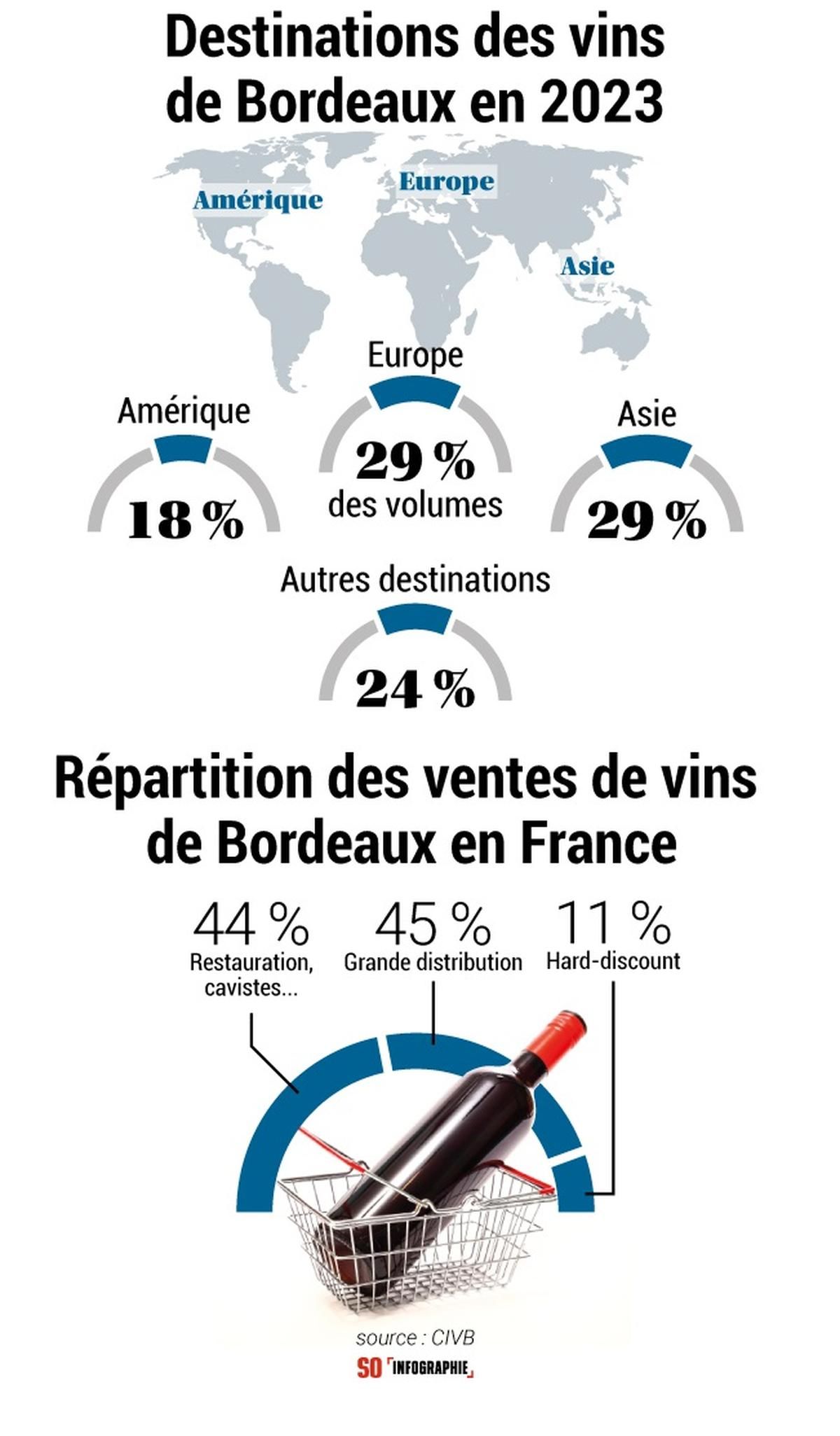he last general assembly of the Interprofessional Bordeaux Wine Council (CIVB) was the opportunity to unveil the stabilized figures for the year 2023. Sales of Bordeaux wines are declining: less 4% in 2023 compared to the year former. But nevertheless 500 million bottles of Bordeaux wine were sold on its various markets, which represents a value of nearly 4 billion euros. Every second, 16 bottles produced and matured in Gironde are sold around the world. Review of details.

SO infographic
1 In France, red is fading
The French market represents 55% of the sales of Bordeaux wines. Main outlet: mass distribution (GD). 45% of Bordeaux sold in France was sold there. It is also the first vineyard with a protected designation of origin (AOP) sold in GD. In this segment, sales continue to erode. Minus 6% for all AOPs, a drop of 5% for Bordeaux. Note that one in three bottles carries an environmental label (organic, HVE, Terra Vitis, etc.). In these supermarkets, we mainly sell red (83%), 10% white, 6% rosé. 44% of sales are made in restaurants, at wine merchants, or online. In 2023, 11% of Girondin wines will be sold in hard discounts.
Unsurprisingly, Bordeaux is suffering the full brunt of the decline in wine consumption: a drop of 70% since the 1960s. It is, logically, the reds (85% of wines produced in Bordeaux) which pay the heaviest price. In ten years, Bordeaux red AOPs have fallen by 45%. To respond to this disaffection, the vineyard is playing the card of diversification of colors (whites, crémants, etc.) but is also working on different red wine profiles (fruity, light, fresh), without however abandoning the “classic” Bordeaux vintages.
2 Exports struggling
Same trend on the international market (45% of sales). In volume, Bordeaux is at 12%, or 208 million bottles sold. In value, the drop is 5%, or 2.23 billion euros. The Chinese locomotive (which includes mainland China, Macau, Hong Kong) is down: less 18% in value (399 million euros), less 17% in volume with 257,000 hectoliters (34 million bottles). We are far from the record of 2017 which saw 717,000 hectoliters in China. To explain it, a phenomenon of over-stocking, political tensions in Hong Kong, the economic slowdown, the health crisis… On this market, Bordeaux remains the leader in French wines.
Behind, we find the United States, where volumes fell (-11%) while value increased by 1% (369 million euros). Translation, Americans are buying less but more expensive wine. We find the same trend in other markets: United Kingdom, Germany, Switzerland. Note the uniqueness of the Belgian market, a strong relationship that stands the test of time. The flat country is the leading European destination for Bordeaux wines: third destination in volume, fifth in value. One of its specificities is that this market appreciates all Bordeaux appellations.
Note, in this ranking produced by the CIVB, the appearance of Côte d’Ivoire, which rises to ninth position in exported volumes. 6 million bottles were sold there in 2023 for a value of 6 million euros, making it the 20the destination in value. In these new territories to work: Africa or, in Asia, India and South Korea. But they are not intended to replace historic markets.
3 The notoriety advantage
It’s a tense time for Bordeaux wines. In this ocean of grayness, Bordeaux has one asset: its notoriety. According to a barometer established by Wine Intelligence, all countries combined, Bordeaux remains the number one vineyard. A global brand, a real asset when almost half of the wines produced in Gironde are consumed abroad.
On the French market, the time of “Bordeaux bashing” seems to be over, especially as the offer has evolved to match new consumption habits. The message is infusing. Here again, Bordeaux is on the top step in terms of notoriety, purchasing and image among consumers. From generation Z (18-24 years old) to “boomers” (55 years and over), it benefits from this recognition.
A trend confirmed by the barometer from the So Wine/Dynata agency: wine has once again become the French people’s favorite alcoholic beverage, ahead of beer. This preference is particularly increasing among women and 26-35 year olds. Still according to this barometer, Bordeaux remains the favorite vineyard of the French, whether they are amateur, neophyte or enlightened consumers.









